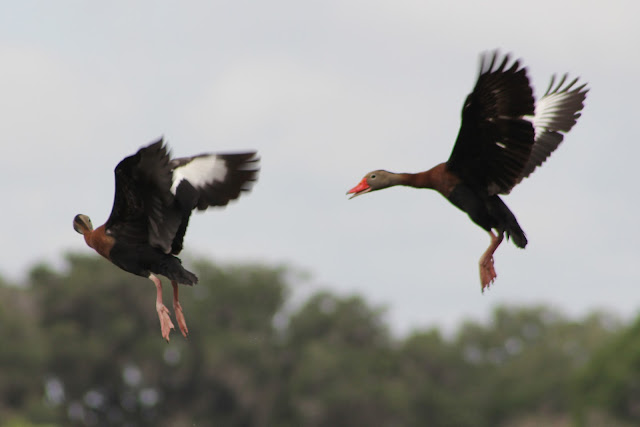Even so, birds are sometimes just plain lay-ZEE.
We've been noticing it more often within the past several weeks, with the weather growing increasingly unpleasant, and the birds doing their best to cope. While these strategies may all have sound adaptive value, having been meticulously honed over the course of millions of years of natural selection, their chief virtue is in making birds look hilarious.
Take the Black Skimmer, for instance. Such an odd-looking bird to begin with, skimmers really take it to the next level with their lugubrious habit of lying out flat, resting with their head and bill extended forward over the ground. It's a behavior that's been depicted in Sibley, but that we'd never actually seen until recently. We were beginning to think it must be an uncommon sight, since we've lived along the coast for several years now and see skimmers fairly regularly, but we must always have been in the wrong place at the wrong time; on this particular beach outing, at least half a dozen skimmers were stretched out in this manner.
 |
| These Black Skimmers look like they've given up on life |
 |
| A couple of lazy skimmers |
I can certainly sympathize with these skimmers -- it can hardly be fun lugging those massive mandibles around wherever they go, and sometimes you've just got to take a load off. In addition to helping the skimmers rest more comfortably, this method of laying out also reduces the amount of heat they absorb (cf. Gochfeld & Burger, 1994), making it doubly helpful… assuming they don't care what anyone else thinks of them.
 |
| Do they make Prozac for skimmers? |
 |
| Black Skimmers |
Another example of an apparently lazy bird is this young Brown Thrasher we found in Forsyth Park last week. He fluffed out all of his body feathers and held himself in a rather peculiar position for some time, even walking around a bit while holding himself in the same position. Unlike with the skimmers, I suspect that this may have been more about delousing. Some ornithologists have proposed that feather fluffing is a means of removing parasites, either by exposing them to sun (as shown) or by dislodging them with dust (cf. Hauser, 1957). In fact, in revisiting the park yesterday, I did see another thrasher (or the same one) holding himself in a similar position, but with the clear intention of saturating his underparts in earthy goodness. Assuming that these behaviors are related, basking, then, may be one tool in the arsenal against mites. This spaced-out looking Northern Cardinal that Maureen digiscoped seems to support that notion. He certainly seemed more interested in sunlight than dirt, anyway -- maybe with the same idea? Hauser (1957) noted that this type of behavior is especially likely after emerging from long, cloudy periods.
 |
| A particularly fluffy Brown Thrasher |
 |
| Spaced-out looking Northern Cardinal |
But the trophy for laziest-looking bird has to go to this Tufted Titmouse sunning at Skidaway Island State Park. As much as he might look like roadkill, he was up and off just a few seconds after Maureen took this photo. I'm not absolutely positive what this ridiculous creature could have been up to, but in trying to figure it out I came across this fascinating old article titled, "Some Observations on Sun-bathing Birds" (Hauser, 1957). I'm sure the science has improved considerably in the 55 years since it was written, but the hypotheses and illustrations are worth a look. One hypothesis in particular had to do with the preen gland. Specifically, when the preening secretions are exposed to sunlight and then ingested, they can provide a source of Vitamin D. And what do you know! In the picture, you can actually see that the preen gland is fully exposed on the titmouse (the pink, fleshy bit just at the base of the tail).
 |
| A Tufted Titmouse doing... something? |
So who's to say a little laziness isn't a good thing? It seems to work for these birds; it's something you should keep in mind next time I go a month without writing a blog post, too. Here's to laziness!
References
Gochfeld, M. and Burger, J. (1994). Black Skimmer (Rynchops niger), The Birds of North America Online (A. Poole, Ed.). Ithaca: Cornell Lab of Ornithology; Retrieved from the Birds of North America Online: http://bna.birds.cornell.edu/bna/species/108
Hauser, D. (1957). Some observations on sun-bathing in birds. Wilson Bull., 69:78-90.



































